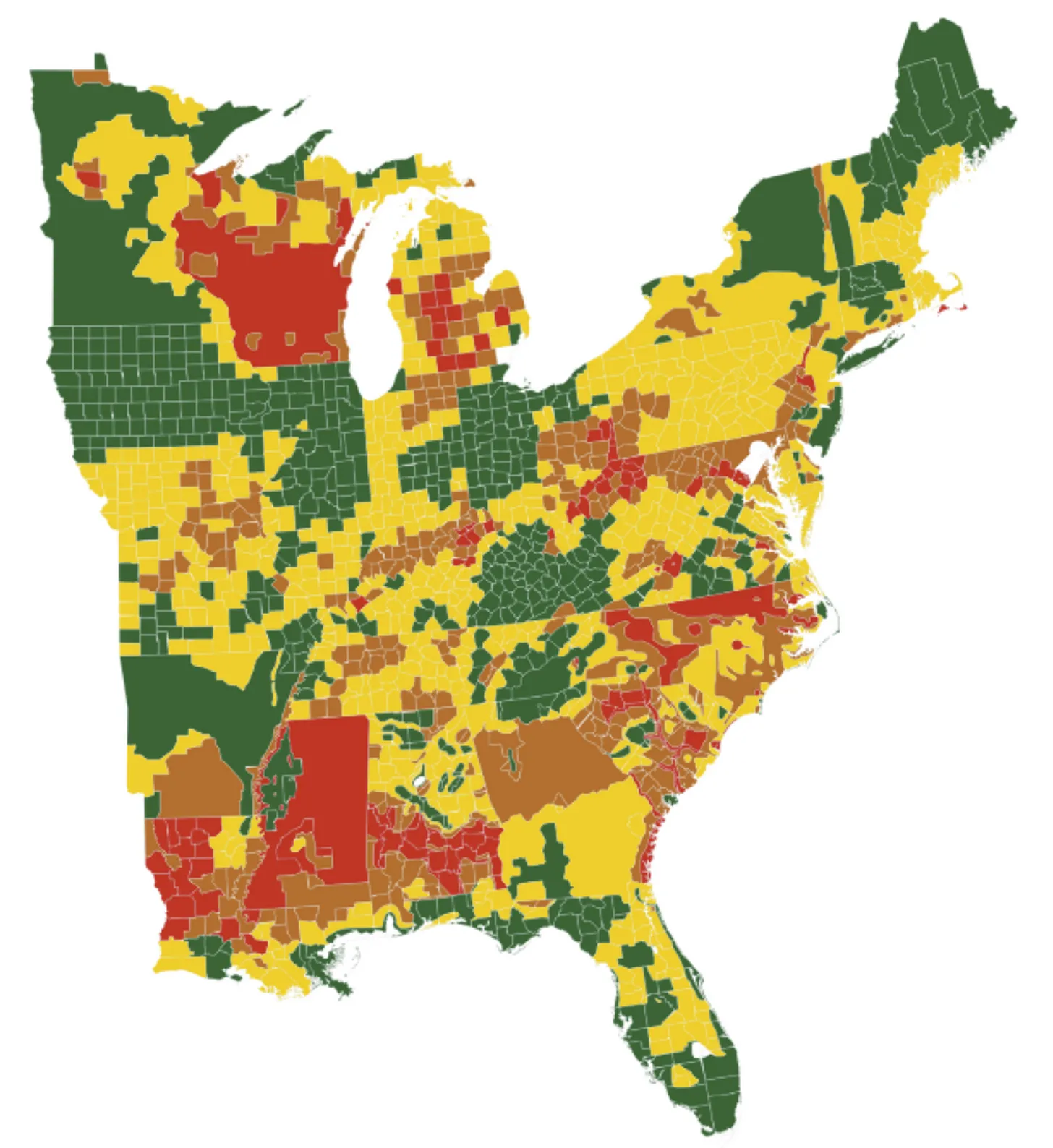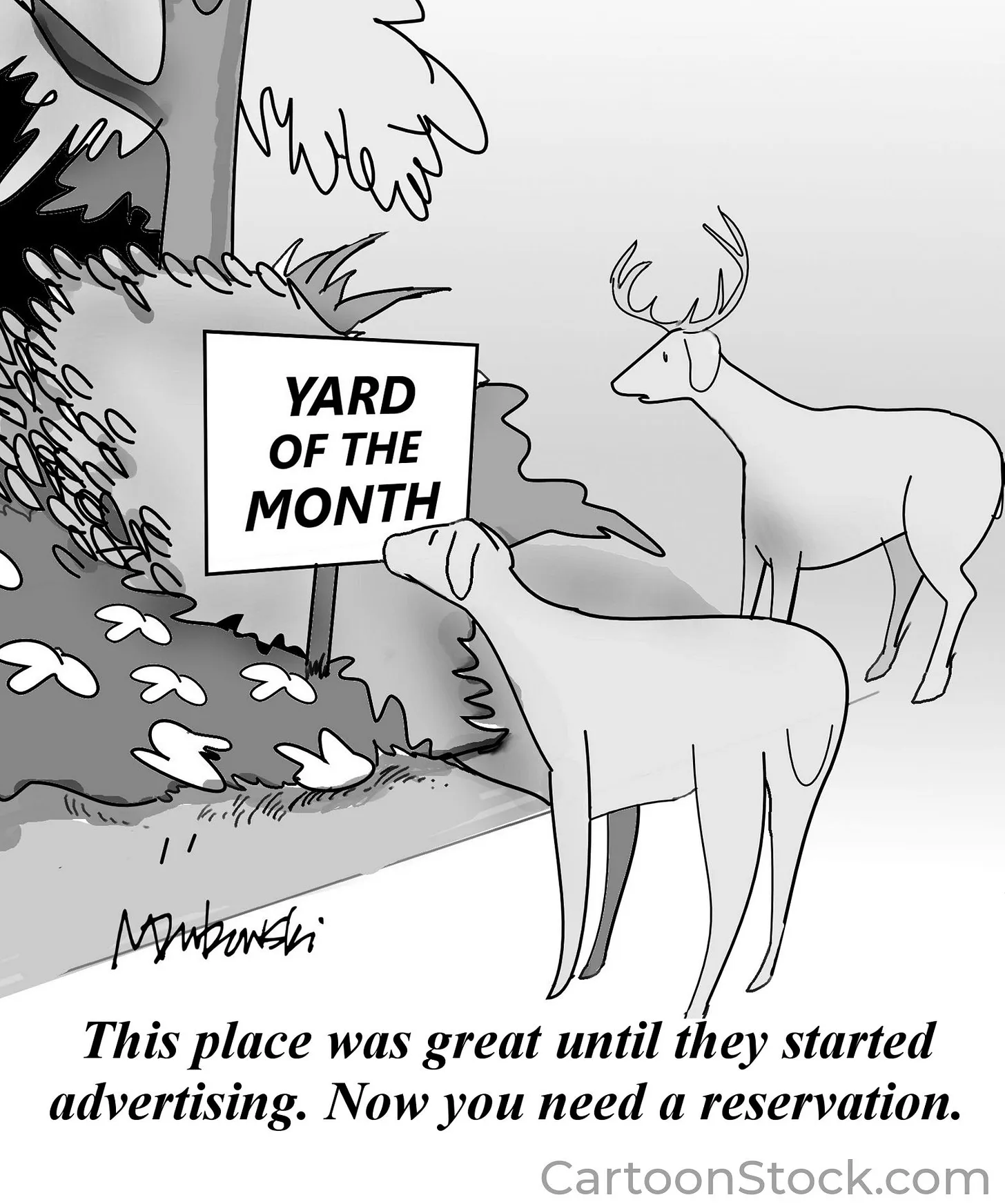Keep Your Plants Safe 🦌
My 3 favorite strategies to protect young plants from deer
Whitetail deer density (2008): red = >45/sq mi; orange = 30-40/sq mi; yellow: 15-30/sq mi; green = <15/sq mi; white = absent or unknown. Source: USDA
Dear Avant Gardener, What is your best suggestion for keeping the deer from eating my plants? I only plant items that are listed as deer resistant and they still munch away. We have three acres on a lake. I am wanting to plant something in a meadow over our septic field. I have about 10 plants in there now and a few daffodils. I covered the deer resistant plants with chicken wire covers until they get a bit bigger. Looking for suggestions to keep deer away. — Anne, Northern Wisconsin
Oh dear, deer! I feel your pain. We anxiously watched from Florida as our security cameras in Rhode Island captured deer munching newly planted shrubs and perennials. What we found on our return was disheartening indeed!
The myth of deer resistance
There’s really no such thing as “deer resistant.” Deer will eat almost any plant if they are hungry enough. That’s largely a factor of season and local conditions — e.g., deer population density and how much food is available to them. Based on studies of the stomach contents of whitetail deer,
Whitetail foods can be classified as browse (leaves and twigs of woody plants), forbs (weeds), grasses, nuts and fruits and mushrooms. Each of these food items vary in availability, depending on the time of year and climatic conditions. . . . Although every study proves that whitetails prefer forbs over all food types, these plants cannot be depended on to be around when deer need them. Forbs generally are more digestible and nutrient-rich. — North American Whitetail
Oddly, deer food preferences also vary by location, so lists of plants deer avoid in one area may not apply in another.
Wildlife biologists classify browse plants into three categories: 1st, 2nd and 3rd choice. . . . It is interesting that some browse species may be a 1st choice in one geographic area and 2nd choice in another. Dogwood is considered a 1st choice plant in eastern Canada, but 2nd choice in the southeastern U.S. — North American Whitetail
In addition, micro location factors like distance from human activity and placement among less desirable plants also impact deer foraging behavior. In our yard, deer decimated several summersweet shrubs, considered deer resistant in the Northeast, but left alone a smooth hydrangea, considered “deer candy.” I think the reason is the summersweet are planted within the yard where the deer feel safe and the hydrangea was planted along the road.
The lure of tender plants
And most frustratingly, newly planted plants act as magnets to both deer and rabbits. Small, new plants have tender new growth and are within easy reach. But I swear curiosity is a factor, too. Animals certainly respond to changes in their environment — like the raccoons that pooped daily on our new kayak after we tied it to our dock. Similarly, rabbits and deer seem to approach new plantings with the attitude, “Gee, what’s this? Does it taste good?” Young plants can be killed by their tasting, whereas established ones survive occasional browsing. And deer apparently have long memories for the location of specific food sources, so once they find something palatable, they will often return.
All this is especially bad news regarding your new meadow plantings. Wisconsin has among the densest deer populations in America. And in the northern part of the state, the Wisconsin Department of Natural Resources aims to increase the population. Plus, you’re planting new forbs in a remote area of a large property.
Ideally, population objectives will produce a healthy herd, a robust ecosystem, fewer deer damage complaints and good hunting and wildlife watching opportunities for everyone to enjoy. — Wisconsin Department of Natural Resources
Here are my top recommendations to protect your plants from deer:
Strategy #1: More plants!
Consider seeding your meadow with deer resistant native perennials, rather than planting individual plants. Your small number of plants must stand out like a sign “Eat me” to foraging deer. In nature, meadow plants grow densely together. The rule of thumb for a meadow is one plant per square foot, so you’ll need many, many more to cover your septic field.
Several seed companies offer native plant meadow mixes designed for septic fields, including this one from Prairie Moon Nursery; you can follow their instructions for planting or the shortcut I describe in 3 Steps to a Make a Meadow. Most of the wildflower genera in the septic seed mix are also included in Prairie Moon’s deer resistant seed mix.
These mixes include native prairie grasses less palatable to deer than forbs, will also make the meadow less attractive to them. If you already have native grasses in the meadow or if the area is shady, you can create your own mixture of flowering forb seeds. (See “How” below for rules of thumb for identifying native perennials less palatable to deer.)
In a few years you’ll have a lush meadow. Deer will munch those forbs they prefer and, through a Darwinian process, you’ll eventually have a sustainable meadow of resilient wildflowers. In the meantime, I recommend using a second strategy to protect the young plants from deer — and rabbits, which can do even more damage to forbs.
Strategy #2: Automatic sprinkler
An easy-to-install, relatively inexpensive way to deter deer is a motion-activated sprinkler. These spray several bursts of water whenever anything moves into range. The two we are testing in our yard are deterring both deer and rabbits from of our new beds. Both have infrared sensors, so they work at night as well as during the day. I recommend this solar-powered Hoont Cobra Animal Repeller [#associate link].
The biggest downside of sprinklers is they don’t work in winter in cold climates. This is a problem if you’re trying to protect shrubs and trees, but your meadow plants die back in winter anyway. In addition, deer can learn to ignore sprinklers.
Strategy #3: Temporary fencing
It sounds as if you’ve tried a temporary chicken wire fence — maybe even successfully? And then the deer ate the plants once you removed the chicken wire? Well, I think it’s worth trying again in combination with the “more plants” strategy. Hopefully, when you remove the fence after the forbs are well established, there will be so many plants that the deer can’t keep up and you can feel good feeding deer those they do get.
Research in Wisconsin found that a 4-foot fence was sufficient to deter deer from an area of eight by sixteen feet. One option for you to keep costs manageable would be to seed or plant plugs in an area this size, then repeat in another area. We’ve done this successfully, keeping both rabbits and deer away from a newly planted bed using chicken wire and these inexpensive metal fence posts [#associatelink]. We removed the fence in late summer and the established woodland sunflowers (Helianthus debilis) are flourishing. (A cage for a single tree should be at least six feet high and fences for larger areas should be eight feet tall.)
I’m not a fan of shutting deer out of a yard entirely. My passion is yards as habitats for people and other creatures to enjoy together. I like to think we can all sacrifice some leaves and branches to feed hungry deer. I can imagine situations when enclosing your yard feels like the right thing to do — for example, you’re trying to protect rare native plants on your property. If you decide to fence part of your yard permanently, see About Deer Fences.
Wishing you a flower-filled summer!
— The Avant Gardener
Why, How, Wow!
Why?
Whitetail deer, common in the Eastern U.S., may be the only native species almost as populous now as they were when Europeans arrived in North America. They had been hunted almost to extinction by 1900. Then the Lacey Act was passed, prohibiting market hunting of deer and other wildlife, and deer populations rebounded. Unfortunately, the quadrupling of the human population since 1900 leaves much less viable habitat to sustain deer.
How
Although there’s no such thing as deer resistance, some plants are less palatable to deer than others. You’ll have to test to see which thrive in your yard — and maintain a spirit of experimentation. To identify native perennials to test, look for these characteristics:
Fuzzy or hairy (e.g., yarrows, coneflowers, black-eyed Susan)
Prickly (e.g., thistle, rattlesnake master)
Aromatic (e.g., hyssops, sages, bee balms, mountain mints, lantana)
Toxic (e.g., false indigos, bleeding hearts, milkweeds, spurges)
Leathery or fibrous (e.g., irises, spiderwort)
Deer dislike, clockwise from top left, fuzzy (black-eyed Susan), touch (blue flag iris), prickly (rattlesnake master), aromatic (anise hyssop), and toxic (swamp milkweed).
Wow!
Here’s a gorgeous garden of plants deer often avoid. Have fund creating your own!
Garden of plants less palatable to deer including Bradbury bee balm (Monarda bradburiana) and black-eyed Susan (Rudbeckia hirta).
Disclosure: As an Amazon Associate I earn from qualifying purchases.





